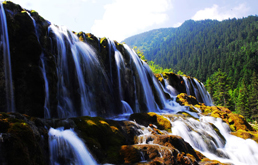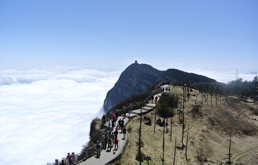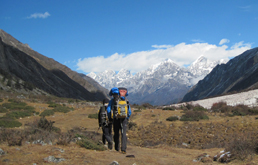Chengdu
Pandas' Hometown
Jiuzhaigou
Famous Fairyland
Emeishan
Sacred Buddhist Site
Leshan
Giant Buddha
Gonggashan
Best for Hiking
Daocheng Yading
Shangri La Views
Dujiangyan
Irrigation System
Siguniangshan
Eastern Alps
Sichuan Provincial Museum is a comprehensive museum and the biggest museum in Sichuan Province. It was first built in 1941 and accommodates pieces of bronze and pottery, Paintings from Zhangdaqian, carved bricks from Han Dynasty, etc. At present it has 14 exhibition halls and over 260,000 pieces of archeological items. Sichuan Provincial Museum has three stories and a total area of over 5 hectares for exhibition. It is located in Huanhua Park in Chengdu. Visitor can use personal ID to get a free ticket from Tuesday to Sunday.

To go to Sichuan Provincial Museum one can use buses. Bus route 19, 35, 58, 82, 151,165 all stop by the museum.

Bronze items excavated from Western Zhou Dynasty to Warring States number 271 pieces in total. The art of forming bronze items by Bashu people had developed independently after 1600BC. This exhibition hall shows the many collections of bronze excavations found in Sichuan Province. Many items were excavated after 1950s at different locations around Chengdu. These bronze items bring archeological significance to study ancient Ba and Shu civilization.

Dafeng Hall is a separated hall opened exclusively for paintings by Zhangdaqian, a very renowned Chinese painter in 20th Century. It has the most collections of Zhang’s work in China. A total of 90 pieces of his works are displayed in the hall. Many Buddhist paintings by Zhang were copied from Dunhuang Grottoes.
The paintings and calligraphies in this hall are from Tang, Song, Ming and Qing Dynasty. A total 113 precious pieces of items are protected here. Among which the most important ones are a Plum Flower with Two Birds by Emperor Huizong from Song Dynasty, a Traveling in an Autumn Mountain by Liusongnian, a Cool Night by an empty Pagoda by Tangyin. Sichuan had many educated visitors during the history from Tang Dynasty, therefore a lot of works left here.
Tibetan Buddhism is a different Buddhism from Chinese Buddhism. In this hall over 200 pieces of Buddhist items displayed to give visitors a good knowledge of Tibetan Buddhism. Among the displayed items, the copper statues and Thankhas are very precious.
Wanfo Temple was once the famous temple in Chengdu, located at Chengdu Tongjin Bridge, founded in the Eastern Han Dynasty (158-167AD) and from the Jin Dynasty to Ming Dynasty over 1000 years it had attracted many visitor and Buddhists. But unfortunately it was destroyed by the end of Ming Dynasty. And after that the temple did not existed. Since 1882 in Qing Dynasty, local people had found the massive carved stone statuaries at Wanfo Temple Ruin. Then it came to known by people again. After 1950s, there were in total over 200 statuaries were discovered in four different times. In Sichuan Provincial Museum, stored most of its excavations include various kinds of Buddha statues, tablets, shrines and other items.
This hall is featured with traditional Chinese crafts and art works in Sichuan. China has a long history and a long history of making things. Exhibitions in this hall show only a small part of Chinese art works. The art works in this hall are in total 252 pieces and categorized into 11 different kinds include jade productions, silver and gold productions, lacquers, Shu Brocade, snuff-bottles, shadow puppets, etc. All the artworks dated back to as early as 3000 years ago to as late as late Republic China.

Sichuan is a multi-ethnic province in China. 14 ethnic groups habituated here for generations, including Tibetan, Yi, Miao, Hui, Mongolia, Lisu, Manchurian, Naxi, Tujia, Bai, Buyi, Dai and Zhuang. In this hall cultures of four major groups are displayed includes Tiebetan, Yi, Qiang and Miao. Yi people are the number one ethnic group in Sichuan, they have in total about 2 million in population residence in southwest Sichuan on the highland. Qing Group is a very old group in China, now they are exclusive in Sichuan. They live by the upper Minjiang River in Aba. Tibetans are the people from highland, the western part of Sichuan are mainly Tibetan areas. The Miao people is also a very interesting group for they have very beautiful costumes and silver decorations. Displayed in this hall are best selected items that represent the essence of ethnic group cultures.
The Sichuan Modern History Hall tells what happened in the last century in Sichuan and Chengdu. Some 300 picture and over 200 pieces of items show the change of local history in Sichuan include the 1911 Baolu Revolution in Chengdu, important figures in Sichuan during Republic China and the long march by the Red Army. It is a very educative hall.
China is the hometown of chinas. 15,000 years ago the Chinese people had managed to make potteries and further on by Han Dynasty, they were able to make fine ceramics. The western world started to know the country on the east from Tang Dynasty when our ceramic making had reached another level. Ceramics had involved in every part of our lives in China. We think it is one of the symbols of human civilization and here, a perfect combination of fire and dirt paste. Displayed in this hall are local excavated ceramics in Sichuan. From simple pottery containers at Shang Dynasty to exquisite pottery figures at Han Dynasty, and later colorful ceramic figures in Song Dynasty, the exhibition shows the development of ceramics in Sichuan.
There are also many seasonal exhibits going on during certain time of the year.
Opening hours: 09:00 to 17:00
The best time to visit Sichuan Provincial Museum is all year round. Visitors need to bring ID card or passport to get a free ticket by the entrance. It opens from 9:00 to 17:00 from Tuesday to Sunday. By Monday the museum is closed. The telephone number of Sichuan Provincial Museum is +86 28 6552 1555
Suggested time of stay 3 hours

Route: Chengdu - Jiuzhaigou

Route: Chengdu - Leshan - Emeishan - Chengdu

Route: Chengdu - Kangding - Gongga - Chengdu